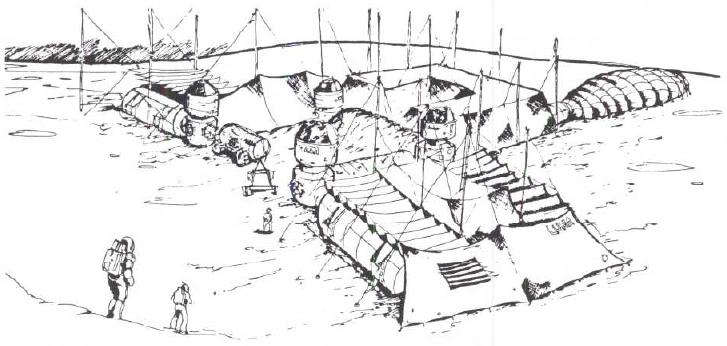Difference between revisions of "Architecture as Tent City"
m (Undo revision 16772 by 190.210.101.137 (talk)) |
|
| (One intermediate revision by one other user not shown) | |
(No difference)
| |
Latest revision as of 21:53, 30 October 2011
Architecture as Tent City
In 1989 the USA discussed returning to the Moon. At that time, the idea failed over the high estimated price. However many useful paper studies were done then that can be of value to us now. One of these described a Manned Lunar Outpost (MLO) as a tent city.
Reference
A detailed study of a Manned Lunar Outpost can be found on the Web at:
The Manned Lunar Outpost (MLO): a NASA/USRA-Sponsored Study
Technical Description
The MLO is made from modules shipped from Earth with an unmanned heavy lift vehicle (HLV). The modules are based on designs of similar modules with a service history in a space station in low Earth orbit.
Modules
The individual habitat modules are sized to fit the bulbous shroud of the HLV. They are also limited in mass to that which the HLV can deliver to the surface of the Moon.
Some of the modules are fixed in size and can be connected end to end to make larger structures. These are strong enough that they can be buried in several meters of lunar regolith to provide thermal and radiation protection.
Some of the modules have an accordion fold center section of fabric that allows them to be deployed into long building sections. These modules provide a lot of floor space for activities like agriculture, but cannot be deeply buried for radiation protection.
General Tenting
One of the most striking innovations in this MLO design is the use of tents over the modules to provide thermal, micrometeorite, and limited radiation protection. The tent material will be strong synthetic cloth with an aluminized coating. Several layers of tent material will be needed with spaces between them.
A small meteorite would hit the top layer of material and explode. Here it is critical to understand that meteorites act like small explosions and not like bullets. The blast debris will then expand out and hit the next layer with less force. Penetration through even a few layers to breach the habitat air bladder would be very unlikely.
The multi layers of the tent will also average out the changes in surface temperature. They will both block direct sun and reduce heat loss at night.
Heavy Tents
A few of the heavy walled modules will be completely surrounded with one layer of heaver tent material and the space between the module wall and the tent filled in with lunar regolith. These modules will provide the crew with full radiation protection during solar storms.
Design Problems
This MLO design does have a number of design concerns that we will have to address:
- Limited radiation protection in the tent only modules
- Aside from the solar storms, the background radiation on the surface of the Moon is harsh enough to be a concern for long term exposure.
- The thermal environment is not specified
- One of the most difficult things to do on the Moon is to keep people and equipment cool at the end of the day. Rejecting excess heat is a major design problem not addressed in this study.
Also the report is dated in some ways such as references to Space Station Freedom and all the Moon people being men. These can be addressed easily.
External Links








